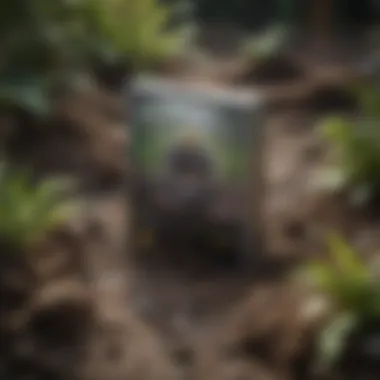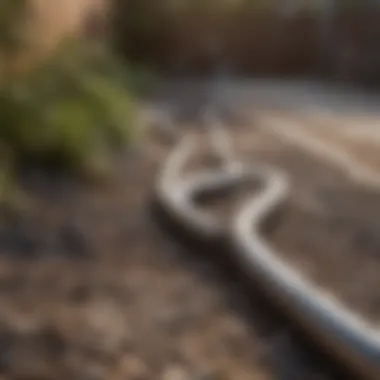Effective Solutions for a Swampy Yard


Intro
A swampy yard can pose significant challenges for homeowners. The landscape becomes a source of frustration rather than enjoyment. Excess moisture can lead to a variety of issues. These issues include unsightly mud patches, insect infestations, and potential water damage to structures. Understanding the root causes of this moisture is critical for effective resolution.
In this piece, we will explore the factors that contribute to a swampy environment. Key issues such as poor drainage, soil composition, and climate considerations will be examined. Additionally, we will discuss practical solutions and strategies for improving drainage. Each aspect of the process will be covered in detail, ensuring readers gain a thorough understanding of how to tackle the problems associated with a swampy yard.
Understanding Swampy Yards
Understanding what constitutes a swampy yard is essential for any homeowner facing issues with excessive moisture accumulation. A swampy yard can lead to various challenges, impacting both the aesthetics and functional aspects of outdoor spaces. If one lives in areas with heavy rainfall or poor drainage, recognizing the characteristics of a swampy yard can help take corrective actions early. Knowing the signs and potential impacts allows for better planning and maintenance. This knowledge not only contributes to the wellbeing of the landscape but also enhances property value.
Defining a Swampy Yard
A swampy yard is typically characterized by consistently soggy soil, resulting in standing water, especially after rainfall. This condition is often the result of multiple factors, including soil composition and local topography. The excessive moisture can hinder plant growth and affect the usability of the outdoor space.
Signs of a Swampy Yard
Recognizing the signs of a swampy yard is crucial for effective intervention. Common indicators include:
- Standing water: Puddles forming after rainfall can persist for days.
- Soil saturation: Soil feels spongy and changes color to a darker hue when wet.
- Limited plant growth: Grass and plants may struggle to thrive in saturated conditions.
- Unpleasant odor: Stagnant water can produce a foul smell due to anaerobic decomposition.
Impact on Property Value
The presence of a swampy yard can negatively influence property value. Homebuyers often shy away from homes with visible drainage issues. A swampy yard can lead to potential long-term problems such as foundation damage, which may deter potential buyers or reduce the property’s market appeal. Addressing these issues early can preserve the home’s value and improve living conditions.
Factors Contributing to Yard Swamping
Understanding the factors that contribute to yard swamping is crucial for homeowners facing excessive moisture problems. Each element plays a significant role in how water accumulates and drains within a yard. Addressing these factors not only improves the drainage, but also enhances the overall appearance and functionality of outdoor spaces. Here, we will dive into soil composition, topography and drainage, and climate factors, each pivotal in determining how swampy a yard can become.
Soil Composition
Clay vs Sand
Clay and sand are two primary components of soil composition, each influencing drainage differently. Clay is fine and dense, retaining water well, which can lead to swampy conditions. On the other hand, sand has larger particles, promoting faster drainage. This key characteristic makes sand a more suitable choice for yards prone to excess moisture. When tackling a swampy yard, it is beneficial to assess the amount of clay in the soil; too much clay can prevent proper drainage, which leads to water accumulation.
The unique feature of sandy soil is its ability to drain quickly, allowing water to flow away from plants and turf, reducing the risk of root rot. However, sand also dries out faster, requiring more frequent watering for vegetation. Balancing these properties is essential when considering soil amendments.
Organic Matter
Organic matter, such as compost or decomposed leaves, plays a vital role in soil health. It improves soil structure, enhancing drainage and allowing better moisture retention and aeration. A yard rich in organic matter can better support plant growth, as it holds nutrients and water effectively.
The key characteristic of organic matter is its ability to improve the soil's physical properties. It can create a more balanced environment for roots. However, relying solely on organic matter can lead to inconsistencies in moisture levels. While it would hold moisture when needed, too much organic matter might also contribute to water retention under certain circumstances.
Topography and Drainage
Natural Slopes
Natural slopes in a yard can divert excess water away from key areas. Recognizing the topography is essential; if a property is flat, it may not drain effectively, causing puddles and swampy areas. The key characteristic of natural slopes is their ability to guide water flow towards designated drainage points, such as rain gardens or drainage ditches.
Understanding the unique feature of these slopes can lead homeowners to strategically design their yards. However, excessive slope can also cause erosion if not managed correctly. Therefore, it is critical to find balance in slope design and implementation.
Obstructions
Obstructions such as trees, buildings, or fences can disrupt the natural flow of water. Identifying these barriers is vital to effectively managing yard drainage. These elements can create pockets where water accumulates, leading to swampy conditions. The key aspect of obstructions is their potential to create areas of standing water, which complicates landscape maintenance.
An obstruction's unique feature is its dual nature. While it can block water flow, it can also offer shelter and shade. Thus, careful evaluation of each obstruction and its effect on water flow is necessary to improve yard drainage while maintaining the integrity of landscaping choices.
Climate Factors


Rainfall Patterns
Rainfall patterns significantly influence yard moisture levels. Regions with heavy rains experience more prominent swampy conditions. The key characteristic of rainfall patterns is their variability, affecting how water accumulates over time. Understanding local rainfall patterns helps in planning the right drainage systems and landscape choices.
The unique feature here is that areas prone to heavy rainfall often require more robust drainage solutions. However, climate change also alters these patterns, making it essential for homeowners to adapt their yard management strategies consistently.
Humidity Levels
Humidity affects how evaporative water loss occurs within a yard. High humidity can lead to slower evaporation rates, contributing to increased moisture levels in the soil. The key characteristic of humidity in this context is its direct correlation with temperature and moisture retention.
Increased humidity can be a problem during warmer months, leading to persistently damp environments. This situation makes it vital to incorporate effective drainage solutions and select suitable vegetation that can thrive in higher moisture levels. Thus, tracking humidity levels is critical for maintaining a healthy yard.
In summary, understanding the factors contributing to a swampy yard is essential for effective management. Soil composition, topography, and climate factors all influence water drainage and retention. Homeowners can mitigate swampy conditions by addressing these issues specifically.
Assessing Yard Drainage Issues
Identifying drainage issues in a swampy yard is a fundamental step towards remediation. Proper assessment can reveal underlying problems that exacerbate moisture retention. Homeowners can save time and resources by addressing these issues effectively. Furthermore, early detection of drainage problems helps to maintain the integrity of landscaping, prevent property damage, and enhance aesthetic appeal.
Performing a Drainage Test
A drainage test is crucial for determining the moisture levels in your yard. This simple test helps to assess how quickly water drains from one area to another. To perform this test, dig a hole about one foot deep and one foot wide in the area that appears most swampy. Fill the hole with water and note how long it takes for the water to completely drain.
- Expected Drainage Time: Ideally, water should drain within 24 hours.
- Interpreting Results: If the drainage occurs slowly or not at all, this indicates poor drainage conditions, likely due to clay-heavy soil or compacted earth.
By conducting this test, the homeowner can pinpoint sections in need of improvement.
Identifying Problem Areas
Once the drainage test is complete, the next step is to identify specific problem areas. Several indicators can help with this process.
- Visual Signs: Look for patches of consistently soggy soil, standing water, or waterlogged grass. Discoloration in plant foliage can also signal drainage issues.
- Soil Analysis: Examine the soil composition. Clay soils tend to retain water, while sandy soils drain more efficiently. This knowledge can direct targeted solutions.
- Topography Considerations: Observe the natural slope of the land. Water tends to run downhill, so areas at the bottom of slopes may collect more water and require special attention.
By marking these areas, you can develop a focused approach to improve drainage.
Documenting Findings
After conducting tests and identifying problematic areas, documenting findings is essential for future reference. A systematic record can guide actions and provide benchmarks for improvement.
- Create a Drainage Report: Include details such as locations of standing water, soil types, and any changes observed during tests.
- Photographs: Taking before-and-after pictures can visually illustrate the effects of any interventions or changes applied.
- Continuous Monitoring: Schedule periodic checks to reassess the yard for changes, especially after heavy rainfall or after making adjustments.
This documentation serves not only as a reference point but also as a tool to measure the effectiveness of implemented solutions.
"Proper assessment of yard drainage issues lays a strong foundation for effective solutions."
By engaging in careful analysis of your yard's drainage conditions, you can create a clear path toward a better-managed outdoor space.
Mitigating Excess Moisture
Mitigating excess moisture is crucial for ensuring that a yard does not become a persistent source of problems. Excess water in the soil can lead to various issues, including poor plant growth, root rot, and increased mosquito populations. By addressing the moisture levels, homeowners can improve the health of their landscape and enhance the overall aesthetic of their property.
Effective moisture mitigation involves several strategies, including enhancing existing drainage systems, adjusting soil composition, and implementing specific landscaping solutions designed for wet conditions. Each of these methods not only helps to manage water levels but also contributes to a longer-lasting solution that will sustain the yard's health and beauty.
Enhancing Drainage Systems
French Drains
French drains are a commonly used method for managing water runoff in yards. They consist of a trench filled with gravel containing a perforated pipe that redirects excess water away from problematic areas. The key characteristic of French drains is their ability to handle larger volumes of water effectively, making them a beneficial choice for swampy yards.
The unique feature of French drains is how they disperse water into a more manageable area, reducing standing water. One of the advantages includes their effectiveness in preventing soil erosion. However, installation can be labor-intensive and costly, which may discourage some homeowners.


Drainage Basins
Drainage basins are another solution to consider when addressing excess moisture. These basins collect runoff from rainstorms and melting snow, allowing it to slowly infiltrate the ground. The importance of drainage basins lies in their ability to manage excess water by creating a storage area that prevents flooding in other parts of the yard.
Their key characteristic is that they can help redirect water flow when appropriately placed. Drainage basins are popular due to their relatively simple design and ease of maintenance. But, they require sufficient space and may become boggy if not properly managed, which can have downsides if not regularly monitored.
Adjusting Soil Composition
Adding Sand
Adding sand to the soil is an effective way to mitigate moisture levels. Sand can improve drainage properties, which allows water to flow more freely through the soil. The key characteristic of sandy soil is its ability to hold less moisture compared to clay, making it beneficial for areas prone to water accumulation.
A significant advantage of adding sand is that it can help balance the soil composition, enhancing aeration and root development. However, overdoing it can lead to water retention issues if not mixed with the right components, like organic matter.
Improving Aeration
Improving aeration is essential for combating excess moisture. Aeration involves creating holes in the soil to allow water and air to penetrate deeper. Its key characteristic is increased oxygen flow to the roots, promoting healthier plant growth. Aeration is a relatively straightforward and effective solution that can be done using various tools or services.
The unique feature of this technique is its ability to foster a healthier root system, which is vital for gardening in swampy conditions. A downside could be the temporary increase in surface water as the soil structure is altered, which may concern some homeowners.
Implementing Landscaping Solutions
Swales
Swales serve as shallow channels designed to direct water away from specific areas in the yard. They are an increasingly popular choice for managing water runoff because they not only help in controlling excess moisture but can also enhance the landscape's aesthetics.
The key characteristic of swales is their ability to vary in depth and shape, making them adaptable for various landscape styles. One advantage is that swales can be quite effective in slowing water, allowing it to soak into the soil, but they may need regular maintenance to remain effective.
Rain Gardens
Rain gardens are another excellent option for managing excess moisture. These gardens are designed to absorb rainwater and reduce surface runoff. Their key characteristic lies in their plant selection, as they utilize moisture-loving species that can thrive in wet conditions.
Rain gardens are beneficial for filtering pollutants from runoff and recharging groundwater, contributing positively to the local ecosystem. A downside might be the need for an appropriate design to ensure they function effectively, which may require professional assistance.
In summary, choosing the right methods for mitigating excess moisture can significantly enhance the functionality and beauty of your yard.
Through strategic improvements, homeowners can create a healthy outdoor space that is more enjoyable and sustainable.
Planting Strategies for Swampy Conditions
Adopting effective planting strategies is crucial for managing a swampy yard. Selecting the right plants can create a healthier ecosystem that thrives in moist conditions. Considerations such as native vegetation and moisture-loving species help enhance the overall resilience of the garden. Moreover, these strategies can contribute to improved drainage, better aesthetics, and support for local wildlife. With the correct selection and arrangement of plants, homeowners can transform their swampy yards into functional and beautiful outdoor spaces.
Selecting Appropriate Vegetation
Choosing the right vegetation is an essential aspect of addressing swampy conditions. Two main categories of plants are especially relevant: native plants and moisture-loving species.
Native Plants
Native plants are those species that naturally grow in a specific region without human intervention. This quality makes them a beneficial choice for swampy yards. The key characteristic of native plants is their adaptation to the local climate and soil conditions, which ensures they thrive even in cases of excess moisture.
One unique feature of native plants is their ability to support local wildlife. Many native species provide food and shelter for birds and beneficial insects. This ability contributes positively to the overall ecosystem in a swampy yard. However, a disadvantage is that some may not provide the same visual impact as exotic species, which might limit aesthetic choices.
Moisture-Loving Species
Moisture-loving species are specifically adapted to withstand wet soil conditions. These plants flourish where water accumulates and can handle periods of saturation without declining. Their key characteristic is their ability to grow in environments that many other plants cannot tolerate, making them an essential choice for swampy landscapes.
A unique feature of moisture-loving species is their diverse range, which includes colorful blooms and unique foliage. They offer homeowners significant visual appeal and can often transform an unattractive swampy yard into an attractive landscape. However, it is crucial to note that some of these species can spread aggressively, potentially outcompeting other plants in the garden.
Creating a Resilient Garden


Building a resilient garden involves thoughtful planning and arrangement of plants. Layering plants and using ground covers are two effective strategies that can enhance moisture management.
Layering Plants
Layering plants refers to the practice of organizing plants in a vertical arrangement based on their heights and growth habits. This creates a more dynamic garden structure. The key characteristic of layering plants is that it optimizes space and encourages a healthier plant community.
A unique feature of layering plants is that it can protect moisture-sensitive species by providing shade, which helps in maintaining soil moisture. This method allows for a diverse range of plants to coexist. However, challenges may arise if certain plant species overshadow others, potentially leading to competition for resources.
Using Ground Covers
Ground covers are low-growing plants that spread across the soil surface, helping to suppress weeds and retain soil moisture. Their key characteristic is their ability to form a dense mat, which is beneficial for controlling erosion and protecting the soil from excessive moisture loss.
A unique feature of ground covers is their effectiveness in connecting different plants while providing color and texture. They can enhance the aesthetic appeal of the garden as well. However, caution must be taken since some ground covers can become invasive, taking over the space meant for other plants.
By selecting native and moisture-loving plants, homeowners can create gardens that not only thrive in swampy conditions but also contribute positively to the surrounding ecosystem.
Long-Term Maintenance and Prevention
Long-term maintenance and prevention strategies are vital for ensuring that a swampy yard does not become a recurring issue. Maintaining proper yard conditions over time helps to reduce excessive moisture accumulation, which can lead to a healthier environment for plants and enhance the aesthetic appeal of your property. Several specific elements contribute to successful long-term maintenance and prevention.
Firstly, regular monitoring of the yard’s condition can identify potential problems before they escalate. Homeowners should be mindful of drainage patterns, soil moisture levels, and any changes in plant health throughout the seasons. Considerations such as using moisture meters may help in determining when to intervene.
Secondly, improving soil composition appears crucial. Incorporating organic matter and ensuring good soil aeration can facilitate better drainage and plant growth. This approach not only helps with moisture management but also enhances soil fertility, promoting a vibrant garden.
Moreover, awareness of environmental factors, such as rainfall patterns, allows homeowners to prepare in advance. Adjusting practices based on seasonal changes can effectively mitigate risks associated with prolonged wet conditions. Importance lays in preventative measures, such as creating barriers to prevent runoff from higher areas, which can significantly help in managing excess water.
By understanding these elements of maintenance, homeowners can create a proactive strategy that addresses potential issues effectively, thus achieving the long-term goal of a healthy yard.
Routine Yard Assessment
Conducting routine yard assessments is an essential component of maintaining a swamp-free environment. Homeowners are encouraged to establish a schedule, perhaps monthly or seasonally, for inspecting their yards. During these assessments, look for new signs of moisture accumulation or drainage problems. It also helps to check for any water pooling in specific areas, which might require immediate attention. Regular checks help you stay ahead of potential flooding and other complications.
Consider using a checklist to ensure consistent evaluations:
- Inspect vegetation for signs of overwatering or damage.
- Check drainage systems for clogs or blockages.
- Examine soil condition—look for compaction or excessive moisture.
Engaging in this routine assessment not only enhances your understanding of the yard’s present condition but can also inform necessary adjustments to improve overall drainage.
Seasonal Adjustments
Seasonal adjustments play a critical role in the effectiveness of long-term maintenance for a swampy yard. As the seasons change, so do the environmental conditions affecting your yard. Early spring may bring melting snow and spring rains, while summer can present heat with potential dry spells. Each season demands specific strategies to manage moisture levels.
In spring, be sure to clear out debris from drainage systems. Evaluate your plants to understand which ones thrive in wet conditions and replace any that struggle in moisture. In contrast, summer maintenance should focus on irrigation adjustments to avoid overwatering, which can lead to swamping during unexpected rain.
In fall, preparing for winter conditions is essential. This can involve adding mulch to protect soil and regulate moisture levels. Each seasonal adjustment is influenced by local climate and specific yard conditions.
Engaging with Professional Services
Professional help can significantly streamline the approach to managing a swampy yard. Utilizing specialized services can save time and ensure that the solutions implemented are effective. There are a few notable professional services to consider:
Consulting Landscape Architects
Consulting with landscape architects brings professional insight in design and planning. A landscape architect analyzes the layout and identifies how to effectively manage water drainage while creating functional outdoor spaces. Their expertise is beneficial for creating tailored solutions that fit the unique challenges of your yard.
The key characteristic of landscape architects is their ability to integrate aesthetic values with environmental needs. This balanced approach results in designs that enhance both the look and function of outdoor areas. A unique feature of their service is their knowledge of local plant species and native flora, ensuring that plant choices align with the yard’s conditions and climate.
However, a downside can be the cost associated with hiring such professionals. For many homeowners, this investment might seem high, but the long-term benefits of a well-designed landscape often offset these initial expenses.
Working with Drainage Contractors
On the other hand, working with drainage contractors provides specific expertise in resolving water accumulation issues directly. These contractors focus on assessing existing drainage systems and recommending improvements or entirely new installations.
Key here is their specialized knowledge in addressing various drainage problems, from surface water management to underground solutions. The primary advantage is that they can implement effective trenches, drains, and other systems designed to facilitate better drainage.
Working with drainage contractors can also be a more straightforward process since they focus solely on the task at hand—ensuring your yard efficiently handles water. The downside might be limited design insight, as their primary focus is not on landscaping aesthetics but rather functional drainage.



